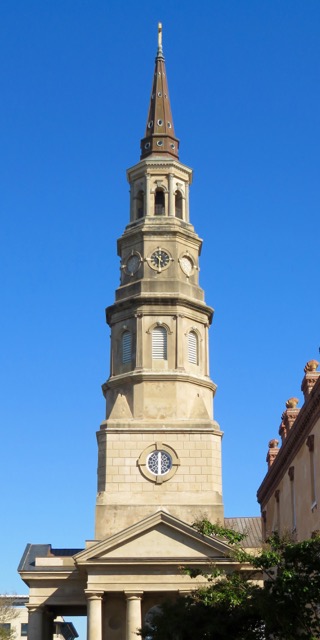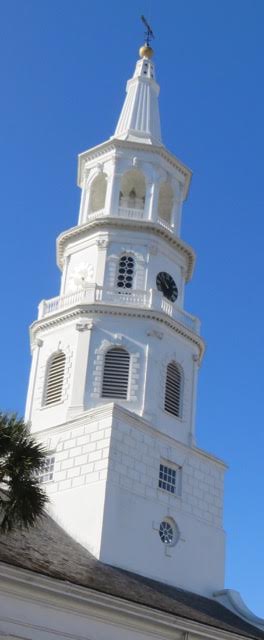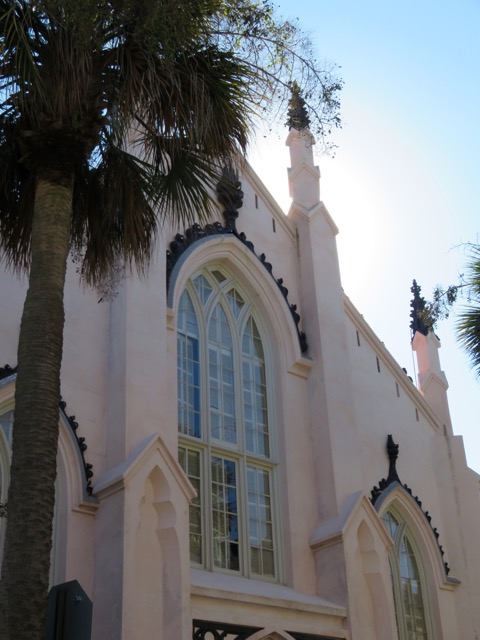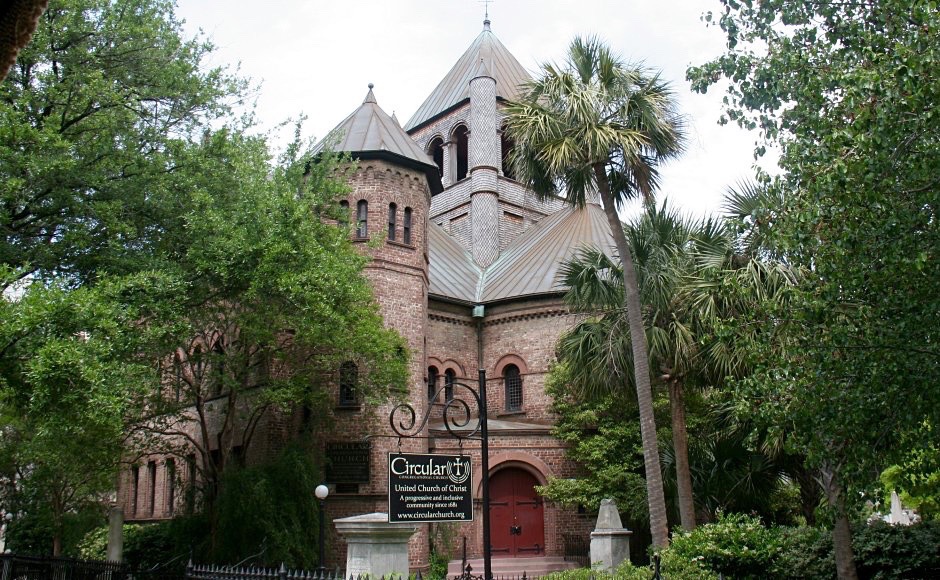We started our second day in Charleston with a houses of worship tour. There were many more sites than the ones I had chosen, but time was a constraint, and we planned to return for a longer stay in the future. Our tour had actually begun the previous day on Sullivan’s Island when I spotted the steeple tower of Stella Maris Roman Catholic Church projecting high over Fort Moultrie. See photo of the fort and the church in my post about Fort Moultrie.
The current Stella Maris Roman Catholic Church is the second Catholic church on Sullivan’s Island, and is one of the oldest in the Charleston area. The first church to sit on the site was the Church of St. John the Baptist. Miraculously, it survived the extensive bombing of Fort Moultrie by federal troops and was the only public building left standing after the Civil War. The initial plan called for a restoration of the small wooden building. But Father Bermingham, vicar general of the Diocese of Charleston, decided to build a new church. He bought the present-day lot for $100 and was granted permission by the secretary of the war to use bricks from the ruins of Fort Moultrie to build the new church. Working side by side, Protestants and Catholics, most of them Irish immigrants who had come to the island to work on projects carried out by the Army Corps of Engineers, helped with the construction of the church. Upon completion, an elaborate ceremony was held to celebrate the dedication of Stella Maris. In attendance were both Protestants and Catholics.

St. Philip’s Episcopal Church
First on my list was the Circular Congregational Church on Meeting Street, originally called the White Meeting House. Founded in 1681 by early colonialists, it was the city’s first non-Anglican church. The colonialists were labeled “dissenters,” and therefore forbidden to call the church a house of worship, only a meeting house. In 1804, the wooden meeting house was replaced with a circular brick building, which was destroyed by fire in 1861. In 1890, bricks from the ruins were used to create the present-day church. A stroll through the church’s cemetery is a must. One tombstone dates back to 1695.
Our next stop was St. Philip’s Episcopal Church, home to the oldest religious congregation in South Carolina and the first Anglican church south of Virginia. The first St. Philip’s Church was built between 1680 and 1681, a modest wooden building located at the corner of Board and Meeting streets. It was damaged in a hurricane in 1710, and a new St. Philip’s Church was built a few blocks away on Church Street. After several setbacks, the church was finally completed in 1723, but it burned to the ground in 1835 and was reconstructed.

St. Michael’s Episcopal Church
What lured me to St. Michael’s Episcopal Church was its iconic 186-foot-high massive white spire with eight bells imported from England in 1764. Of note, it was here in the cedar-box pews that George Washington and General Robert E. Lee worshipped. The first church to sit on this site was the first St. Philip’s Episcopal Church, the wooden building damaged by the hurricane of 1710.
A friendly woman welcomed us as we climbed the steps to the French Huguenot Church. I first learned about the denomination while living in South Africa. The church traces its beginnings to 1680 when French Protestants—Huguenots—were sent by King Charles II to the new colony as artisans and tradesmen. In 1685, when the Edict of Nantes (1598) was revoked, Huguenots arrived in numbers in America, where they could freely practice their Calvinistic faith. The Gothic Revival-style structure was built of brick and covered in rose-tinted stucco, complementing the roof’s black iron finials. I was quite captivated by the church’s appearance.
 The Edict of Nantes was, in my opinion, Henri IV’s greatest achievement. The terms of the edict ensured the peaceful coexistence of Catholics and Protestants and ended religious hostilities in France after thirty-six years of civil warfare. But in 1685, Louis XIV revoked the edict, and a Protestant exodus began. The French Huguenots who fled France for South Africa arrived in the Cape of Good Hope between 1688 and 1689. These French immigrants and their descendants made important contributions to the Western Cape’s viticulture and oenology industries, and to this day, a number of wine estates still bear their Huguenot surnames.
The Edict of Nantes was, in my opinion, Henri IV’s greatest achievement. The terms of the edict ensured the peaceful coexistence of Catholics and Protestants and ended religious hostilities in France after thirty-six years of civil warfare. But in 1685, Louis XIV revoked the edict, and a Protestant exodus began. The French Huguenots who fled France for South Africa arrived in the Cape of Good Hope between 1688 and 1689. These French immigrants and their descendants made important contributions to the Western Cape’s viticulture and oenology industries, and to this day, a number of wine estates still bear their Huguenot surnames.
The Cathedral of St. John the Baptist has dominated the Charleston landscape for over a hundred years and is one of the many churches that gives Charleston its nickname “The Holy City.” The Gothic Revival cathedral is home to the Roman Catholic Diocese of Charleston and is considered the “mother church.” It was built in 1854 on a less-than-holy site—Vauxhall Gardens—a post-Revolutionary “pleasure garden.” The cathedral burned down in the Great Fire of 1861 and was rebuilt on the foundation of the previous church. The structure is a Connecticut brownstone with a five-light window copied from Leonardo Da Vinci’s The Last Supper and a beautiful rose window.
 Founded in 1749, Kahal Kadosh Beth Elohim (KKBE) Synagogue is the second oldest Jewish house of worship in the US and the oldest one in continuous use. Charleston was known for its religious tolerance, so people of the Jewish faith began emigrating to “The Holy City” as early as 1695. The oldest synagogue in the US is Touro Synagogue in Newport, Rhode Island.
Founded in 1749, Kahal Kadosh Beth Elohim (KKBE) Synagogue is the second oldest Jewish house of worship in the US and the oldest one in continuous use. Charleston was known for its religious tolerance, so people of the Jewish faith began emigrating to “The Holy City” as early as 1695. The oldest synagogue in the US is Touro Synagogue in Newport, Rhode Island.
Across the street from KKBE is St. Mary’s Roman Catholic Church, the first Roman Catholic church in the Carolinas and Georgia. By the late eighteenth century, Charleston had a sufficient number of Catholic immigrants to warrant building a church. In 1788, Reverend Ryan, an Irish priest, arrived in Charleston, and in 1801 construction began on the church. In the meantime, the congregation worshipped in the dilapidated Methodist meeting house that was on the site. Most of the church burned during the Charleston fire of 1838. It was rebuilt and completed in 1839 in the Classical Revival style.
The last church, Emanuel African Methodist Episcopal (AME) Church, brought tears to my eyes—tears for the nine fatally shot on June 2015 during weekly Bible study. The Gothic Revival building with its signature steeple was built in 1891, replacing a wooden building from 1872 that was damaged during the Charleston earthquake of 1886. The church dates back to 1816, when Morris Brown organized a withdrawal of the Charleston Methodist Episcopal Church’s black members over a burial ground dispute. The newly formed congregation soon established themselves as an AME, a denomination founded in Philadelphia by Reverend Richard Allen, and it is the oldest AME church in the South.
We spent the rest of the day soaking up Charleston’s history, enjoying its charm, and admiring its architecture, ending with dinner at SNOB (Slightly North of Broad)—shrimp with grits and peanut butter pie.
Side note: I had no idea how many fires Charleston had experienced until I dug into the city’s history. Learn more here on the Preservation Society of Charleston website.




0 Comments